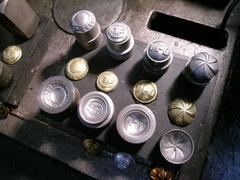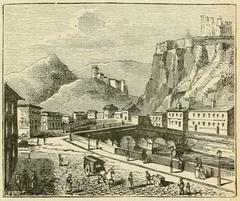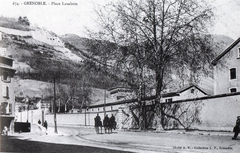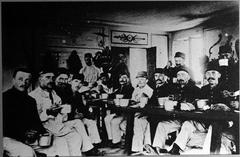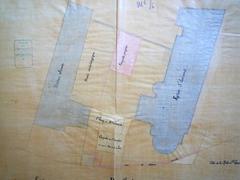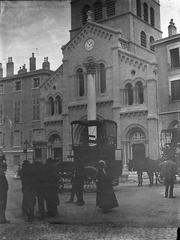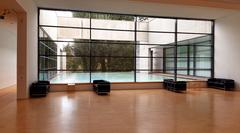
Natural History Museum of Grenoble: Visiting Hours, Tickets & Comprehensive Visitor Guide
Date: 03/07/2025
Introduction
Nestled in the heart of the French Alps, the Natural History Museum of Grenoble (Muséum d’Histoire Naturelle de Grenoble) is a landmark of scientific inquiry, cultural heritage, and public education. Founded in the mid-19th century, the museum preserves and showcases the biodiversity and geological wonders of the Alpine region, while advancing Grenoble’s legacy as a city committed to science and community engagement. With over 1.5 million specimens spanning zoology, botany, paleontology, mineralogy, and ethnology, the museum offers an immersive experience for all ages.
Housed in a historically significant early 20th-century building at 1 Rue Dolomieu, the museum combines architectural elegance with modern accessibility. Its proximity to the Jardin des Plantes botanical garden and Grenoble’s major cultural sites makes it an ideal starting point for exploring the city’s scientific and artistic heritage.
This guide draws on authoritative sources to provide a detailed overview of the museum’s history, architecture, collections, visiting hours, ticketing, accessibility, and practical visitor tips for a rewarding experience (whichmuseum.com, grenoble-tourisme.com, The Museum Scholar).
Table of Contents
- Introduction
- Historical Overview and Architectural Significance
- Essential Visitor Information
- Exploring Collections & Museum Highlights
- Educational Role, Research, and Community Engagement
- Practical Details: Hours, Tickets, Accessibility
- Travel Tips & Nearby Attractions
- Frequently Asked Questions (FAQs)
- Visual Experience & Media Suggestions
- Conclusion and Visitor Tips
- References
Historical Overview and Architectural Significance
Origins and Development
Founded in 1851, the Natural History Museum of Grenoble emerged from a broader 19th-century movement to democratize scientific knowledge and preserve regional natural heritage. The museum’s early collections were built by local naturalists and scholars, documenting the unique flora, fauna, and minerals of the Alps. Over time, acquisitions from expeditions and exchanges with other institutions expanded its scope, establishing it as a leading center for research and education in southeastern France.
Role in Grenoble’s Cultural Landscape
The museum is one of five major historical museums in Grenoble, alongside the Museum of Grenoble, Museum of the Former Bishopric, Museum of the Resistance and Deportation of Isère, and the Dauphinois Museum (whichmuseum.com). Its presence underscores the city’s dedication to preserving and disseminating knowledge. The museum supports public understanding of Alpine ecosystems and regularly hosts exhibitions, educational workshops, and outreach programs.
Architectural Significance
The museum’s building, dating to the early 20th century, features classical architectural elements such as symmetrical stone façades, large windows for natural light, and durable materials. Its interior is designed for both educational engagement and collection preservation, with spacious exhibition halls, climate control, and specialized displays. Ongoing renovation and preservation efforts ensure the building remains accessible and historically authentic (overyourplace.com).
Essential Visitor Information
Location & Accessibility
- Address: 1 Rue Dolomieu, Grenoble
- Access: Centrally located, easily reached by public transport, bicycle, or on foot
- Accessibility: Ramps, elevators, and accessible restrooms ensure comfort for all visitors
Opening Hours
- Tuesday to Sunday: 10:00 AM – 6:00 PM
- Closed: Mondays and select public holidays
- Note: Hours may vary during holidays or special events; always check the official website for updates
Admission & Ticketing
- General Admission: €5–€7 (see section below for detailed breakdown)
- Reduced Admission: Students, seniors, and groups
- Free Entry: Children under 18, residents of Grenoble, and on select cultural event days
- Tickets: Purchase on-site or via online portal. Advance booking is recommended during peak periods.
Facilities & Services
- Guided Tours: Available in multiple languages (advance booking advised)
- Educational Programs: For families, school groups, and lifelong learners
- Gift Shop & Café: Offering books, souvenirs, and refreshments
- Restrooms: Accessible facilities throughout
COVID-19 Guidelines
The museum follows current health protocols, including mask recommendations, hand sanitizing stations, and social distancing. Check the museum’s website for the latest updates.
Exploring Collections & Museum Highlights
Permanent Collections
The museum’s vast holdings span several scientific domains:
- Botany: The historic Dominique Villars Herbarium, digitized and accessible online; regional alpine flora; rare plant specimens
- Zoology: Alpine mammals and birds, invertebrates, and global specimens; dioramas illustrating native habitats
- Paleontology: Fossils from the Dauphiné and Alpine regions, including trilobites and ammonites; interactive displays on prehistoric life
- Mineralogy & Geology: Extensive mineral and rock collections, including specimens from the Dauphiné mountains; displays of alpine crystals
- Ethnology & Anthropology: Exhibits highlighting the relationship between humans and the Alpine environment
Must-See Exhibits
- “In the Earth’s Own Words” Room: 101 original fossils presented with modern museography (grenoble-tourisme.com)
- Crystal Symphony: Dazzling display of regional minerals and crystals
- Temporary Exhibitions: Rotating thematic exhibitions, workshops, and public lectures
The Botanical Garden
Adjacent to the museum, the Jardin des Plantes features rare trees, 300 m² of greenhouses, and a rich collection of alpine and exotic plants, offering a tranquil extension to your museum visit (grenoble-tourisme.com).
Educational Role, Research, and Community Engagement
- Formal Education: Guided school tours, curriculum-linked workshops, and resources for teachers (The Museum Scholar)
- University Partnerships: Research collaborations and academic events with local institutions
- Accessibility & Inclusion: Tactile and multisensory exhibits, traveling displays to underserved communities, and online digitization projects
- Citizen Science: Public biodiversity surveys, transcription of specimen records, and hands-on identification workshops (UCL Discovery)
- Research & Conservation: The museum’s collections underpin studies on climate change, biodiversity, and environmental stewardship
Practical Details: Hours, Tickets, Accessibility
Visiting Hours
- Monday: 10:00 AM – 6:00 PM
- Wednesday to Sunday: 10:00 AM – 6:00 PM
- Closed: Tuesday
(Note: Some sources report slightly different hours; always confirm on the official website)
Ticket Prices
- Adults: €7
- Reduced Rate: €5 (students, seniors, groups)
- Children under 18: Free
- Special Events/Workshops: May have a separate fee
Accessibility
- Wheelchair access and elevators throughout
- Adapted restrooms and resources for visitors with disabilities
- Assistance available upon request
Getting There
- Address: 14 Rue Hébert, Grenoble (note: some sources also use 1 Rue Dolomieu; check directions)
- Public Transport: Tram A/B (Palais de Justice), Tram C (Hôtel-de-Ville), Bus line 15 (Bir Hakeim)
- Parking: Limited in the city center; “Parking Sainte-Claire” and “Parking Saint-Laurent” are nearby
- Bike-Friendly: Racks available at entrance
Travel Tips & Nearby Attractions
- Best Times to Visit: Quieter on weekday mornings; weekends are popular with families
- Suggested Duration: 1.5–2 hours for museum and garden
- Combine with: Museum of Grenoble (art), Dauphinois Museum (regional history), and the Bastille cable car (thecrazytourist.com)
- Jardin des Plantes: Enjoy a stroll before or after your museum visit
Frequently Asked Questions (FAQs)
Q: What are the Natural History Museum of Grenoble’s visiting hours?
A: Generally, Tuesday to Sunday 10:00 AM–6:00 PM (closed Monday or Tuesday depending on the source). Check the official site for current hours.
Q: How much do tickets cost?
A: Adults €7, reduced €5, children under 18 free. Admission is free as of 2025 for most exhibitions (grenoble-tourisme.com).
Q: Is the museum accessible for visitors with disabilities?
A: Yes, with ramps, elevators, accessible restrooms, and adapted resources.
Q: Are guided tours available?
A: Yes, in French and by request in other languages. Booking in advance is recommended.
Q: Is there parking nearby?
A: Yes, but limited; public transport is recommended.
Visual Experience & Media Suggestions
- Exterior: “Natural History Museum of Grenoble entrance” — historic façade with clear signage
- Interior: “Dominique Villars Herbarium specimen,” “Interactive exhibit at Natural History Museum of Grenoble,” “Alpine wildlife diorama”
- Botanical Garden: Images of rare trees and greenhouse spaces
For a preview, visit the museum’s official gallery.
Conclusion and Visitor Tips
The Natural History Museum of Grenoble is an essential stop for anyone interested in natural history, science, or the Alpine region’s cultural heritage. With free or affordable admission, robust accessibility, and a rich slate of educational programs, the museum offers an engaging experience for all. Combine your visit with a stroll in the Jardin des Plantes and nearby historical sites for a comprehensive Grenoblois adventure.
Key Tips:
- Check visiting hours and book tickets in advance if possible
- Plan weekday visits for a quieter experience
- Take advantage of guided tours and digital resources
- Explore the botanical garden and nearby museums for a full day in Grenoble
For real-time updates, downloadable guides, and more, follow the museum on social media, consult the official website, and try the Audiala app for curated content.
References
- Visiting the Natural History Museum of Grenoble: Hours, Tickets & Highlights of Grenoble’s Premier Historical Site, 2025 (whichmuseum.com)
- Exploring the Natural History Museum of Grenoble: Visiting Hours, Tickets, and Attractions, 2025 (The Museum Scholar)
- Natural History Museum of Grenoble Visiting Hours, Tickets, and Collections Guide, 2025 (museum-grenoble.fr)
- Natural History Museum Grenoble Visiting Hours, Tickets & Visitor Guide, 2025 (grenoble-tourisme.com)
- UCL Discovery, 2019 (UCL Discovery)
- Additional local insights (overyourplace.com), (adventurebackpack.com), (france-voyage.com), (thecrazytourist.com), (wikipedia)

